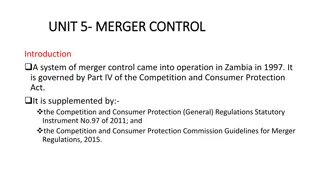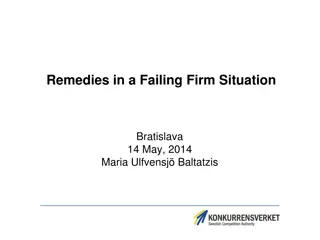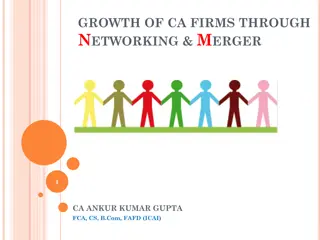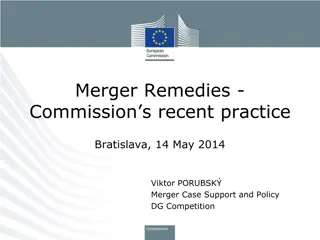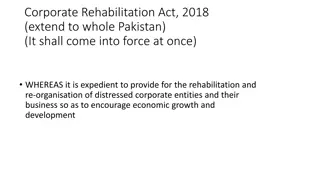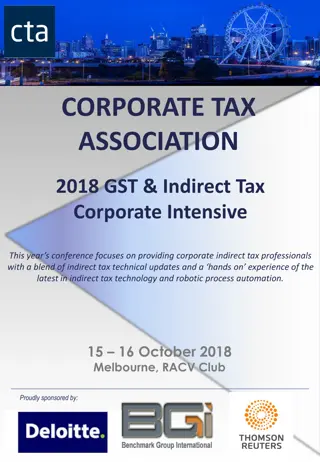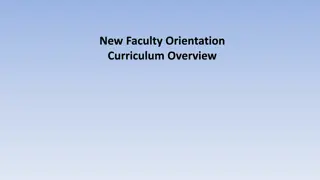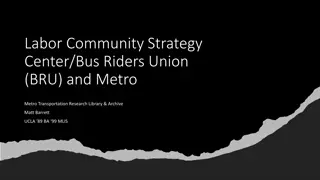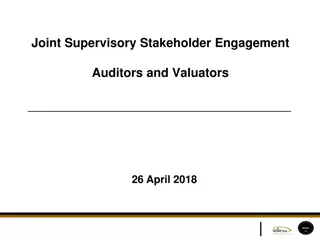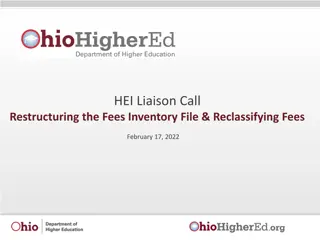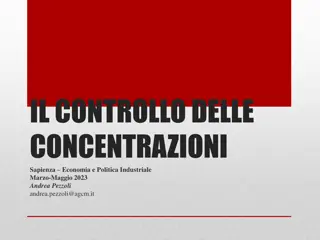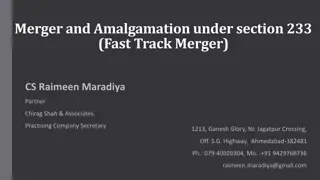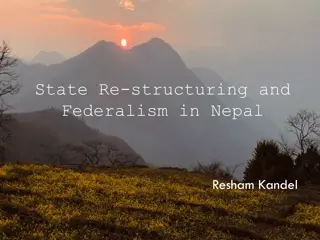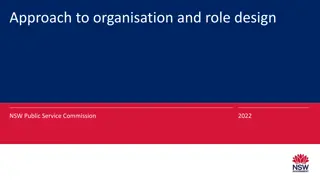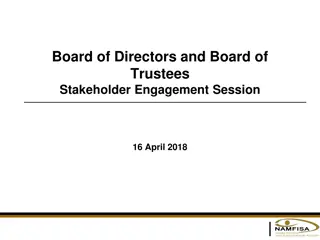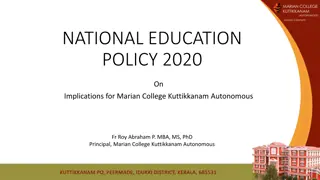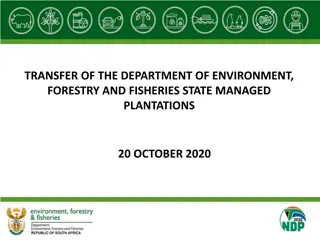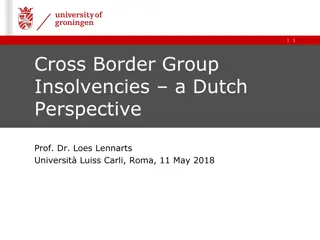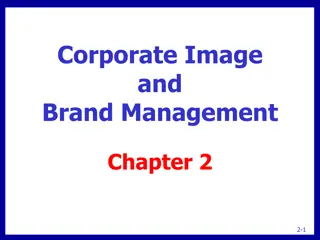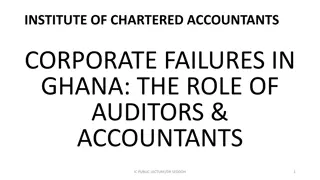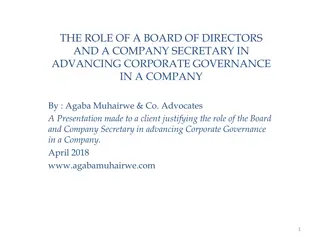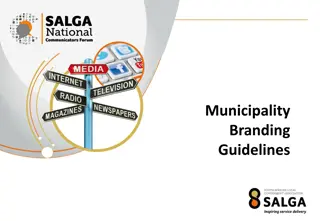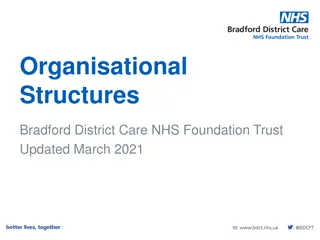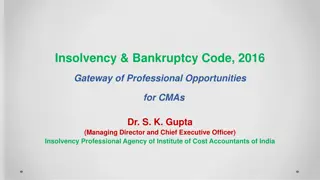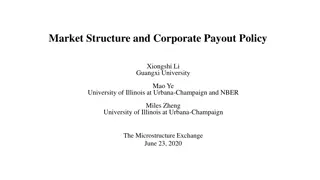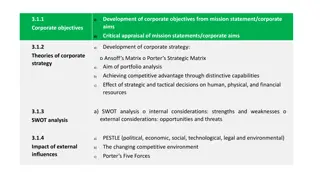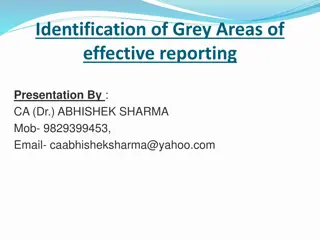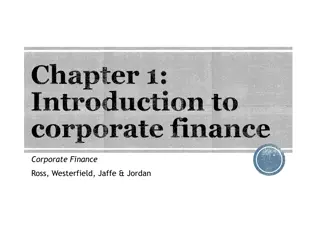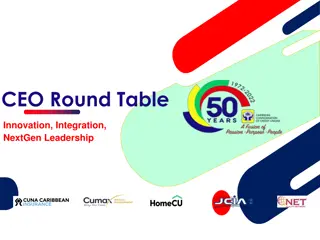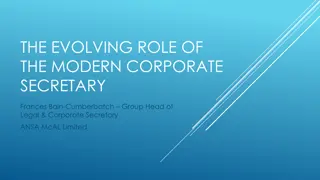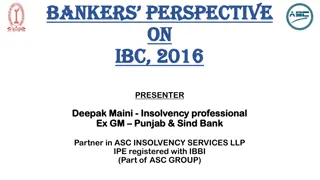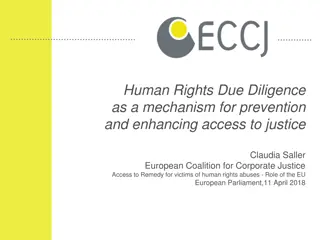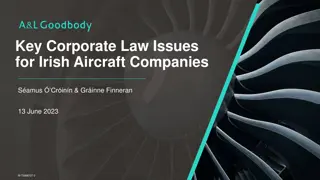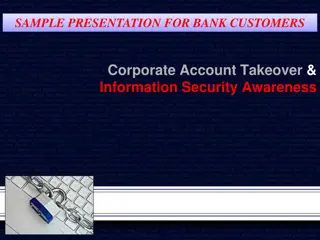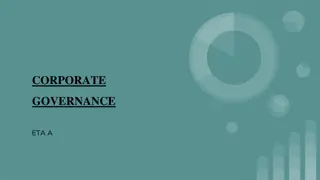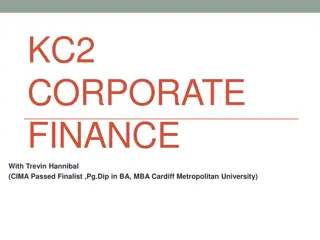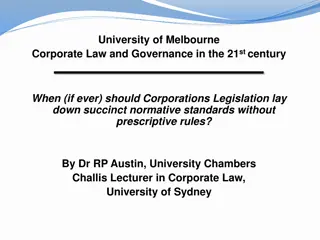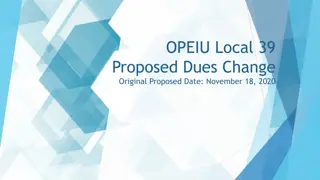Corporate Restructuring and Merger Overview
Explore the benefits, types, and legal aspects of corporate restructuring, mergers, and amalgamations. Learn about transfer of assets, economies of scale, merger types, and landmark cases related to compromise and arrangements with creditors and members.
Download Presentation

Please find below an Image/Link to download the presentation.
The content on the website is provided AS IS for your information and personal use only. It may not be sold, licensed, or shared on other websites without obtaining consent from the author. Download presentation by click this link. If you encounter any issues during the download, it is possible that the publisher has removed the file from their server.
E N D
Presentation Transcript
Compromise, Arrangement and Amalgamation
OVERVIEW Corporate Restructuring Benefits of Merger and Amalgamation Types of Merger Legal Aspect (Section 230 Section 234) Single Window Clearance Foreign Exchange Management (Cross Border Merger) Regulation, 2018 Stamp Duty Aspect Competition Act Aspect - Combination
Corporate Restructuring Transfer of assets and liabilities involved Transfer of assets and liabilities not involved External restructuring Internal Restructuring Sacrifice by shareholders Demerger Merger & Amalgamation Sacrifice by creditors
Economies of Scale Diversification Elimination of Competition Utilisation of Tax Shields Better Financial Planning Economic Necessity Synergy Gain
Horizontal Merger TYPES OF MERGER Congeneric Merger Vertical Merger Conglomerate Merger
SECTION 230 : Power to Compromise or Make Arrangements with Creditors and Members
Application for C & A between Co & M or Co & Cr Company Order meeting of Cr or M Within NCLT OR Creditors Member Co. ROC Shall disclose by Affidavit 1) All Material Facts 2) Reduction of Share Capital 3) Corporate Debt Restructuring Binding Order 30 days Liquidator Notice + Copy of Scheme, Valuation Report, Effects on Directors, KMP etc. Cr, DH, M Advertisement of Notice Sectoral Regulators Stock Company s Website Objections Approval Newspapers Seeking Representation within 30 Days Exchange & SEBI Website At least 10% of total share holding At least 50% majority At least 3/4th in value O R At least 5% of total o/s debt &
Landmark Cases u/s 230: 1) Re. Vasant Investment Corporation Ltd. (1982) : An arrangement under this section can also take a company out of winding up. 2) Rajdhani Grains and Jaggery Exchange Ltd. (1983) : Even though a winding up order has been made, every member has a right to file an application u/s 391 (presently s. 230) for the revival of company. 3) Laurel Aromatics Pvt. Ltd. In, Re. (2011) : High Court can sanction the scheme of arrangement/ amalgamation of one company with another company, even though there is no such enabling provision in the MOA of the transferor or the transferee company. The power of amalgamation/ arrangement by way of scheme is statutorily available. 4) Kirloskar Electric co. Ltd. Re. (2003) : The majority of the 3/4th value must be of the persons who are present and have taken part in the voting. Thus, mere presence would not be enough.
SECTION 231 : Power of Tribunal to enforce Compromise or Arrangement
If NCLT thinks that - Supervise the implementation of the Scheme as per the order The order passed u/s 230 can t be implemented by the company satisfactorily + The company is unable to pay the debts to the creditors then - NCLT Order passed u/s sec. 230 + Give such directions as it may consider necessary for proper implementation. Such winding up order shall have the same effect as compulsorily Order of Winding Up may be winding up of the company u/s. 273 given by NCLT
Landmark Case u/s 231: 1) S. K. Gupta v/s K. C.Jain (1979) : If the scheme is workable with or without modification, the court has no power to pass a winding up order u/s 392 of 1956 Act. The court must attempt to find out what modifications if any, are necessary to make scheme workable, and if necessary, may proceed suo-motu in this regard.
SECTION 232 : Merger and Amalgamation of Companies
Order meeting of Cr or M M & A Within Application made for ROC Co. NCLT Transfer of property, undertaking or liabilities 30 days Sanctioning Order 1) Transfer whole or any part of undertaking/assets/liabilities 2) Allotment of Shares/Deb. To SH of Transferor Company 3) Transferor company stands to be dissolved w/o winding up process 1) Notice of meeting 4) Employees of transferor co. becomes employees of transferee co. 2) Draft of proposed terms of schemes 5) Continuation of all legal proceeding of transferor company in the 3) Confirmation of filing scheme with ROC name of transferee company 4) Effect of scheme on KMP, Pr., Non Pr., SH 6) Cancellation of crossholding of shares 5) SWAP Ratio 7) Provision of exit price for dissenting SH 6) Valuation Report 7) Supplementary Accounting Statements NOTE: 1) NCLT shall not issue confirmation order unless auditor provides a certificate confirming that the proposed scheme of C & A is in accordance with accounting standards. 2) Every company w.r.t NCLT order shall file annual statement duly certified by PCA/PCS/PCWA to ROC that scheme complied as per NCLT order.
SINGLE WINDOW CLEARANCE When the scheme envisages various incidental proposals as an integral part of scheme , the procedures prescribed under the Companies Act, need not be separately undertaken. Landmark Cases : 1) Jaypee Cement Ltd. Re. (2004) : Change of name can be carried out as a part of scheme. 2) Rangkala Investments Ltd., Re. (1997) : Procedure for change in object clause need not be separately followed. 3) Stephon Walters & Sons. Ltd. (1926) : The court can sanction reduction of capital as a part of the scheme.
SECTION 233 : Merger and Amalgamation of certain Companies FAST TRACK MERGER
Notice + Copy of Scheme Explanatory statement Declaration of solvency Small companies Sec. 233 FAST TRACK MERGER Holding co. and its WOS Persons affected by scheme ROC OL Communicate with CG within 30 days whether having any objection/suggestions or not Redraft scheme by considering objections and suggestions OL RO C Follow Sec. 232 If objection received Valid objection Approval Objection valid and scheme is not in public interest Objection invalid and scheme is in public interest NCLT CG Majority creditors holding at least 9/10th of value of debt Members holding at lest 90% of total shares & Invalid objection If no objection received Issue confirmation order
IS FAST-TRACK MERGER ACTUALLY FAST? The answer is NO...!!! Some of its major drawbacks are : DEFECTS OF FAST TRACK MERGER Multiple Clearance Time Consuming No Scope of Demerger
SECTION 234 : Merger and Amalgamation of a Company with Foreign Company
Foreign Company + Follow rules of CG in consultation with RBI AMALGAMATION Indian Company Mandatory Approval of RBI NO YES Cancel the scheme Payment of Consideration to SH Only after getting an approval from RBI, application has to be made to NCLT u/s 230 or 232, as the case may be. Cash OR Depository Receipt OR If approved by NCLT, then FC & IC are merged Partly Cash & Partly Depository Receipt
Transfer / Issue of Securities Situated Office Acquisition of asset or security Resultant Company INBOUND MERGER V/S OUTBOUND MERGER
Stamp Duty Instrument Execution As per sec. 2(i) of Bombay Stamp Act, 1958, Instrument includes every document by which any right or liability is or purports to be created, transferred, limited, extended, extinguished or recorded but does not include a bill of exchange, cheque, promissory note, bill of lading, letter of credit, policy of insurance, transfer of shares, debentures, proxy and receipt. LANDMARK CASE: Li Taka Pharmaceuticals v. State of Maharashtra (1996) Order of the court = Instrument State has jurisdiction to levy stamp duty under entry 44 list III Stamp duty would be levied on net assets.
COMBINATION UNDER COMPETITION ACT, 2002 Applicable To Assets Turnover IN INDIA Individual Rs. 2000 Cr. Rs. 6000 Cr. Group Rs. 8000 Cr. Rs. 24000 Cr. Assets Turnover Minimum Indian Component Out of Total Applicable To Minimum Indian Component Total Total IN INDIA AND OUTSIDE Individual Parties $ 1 Bn. Rs. 1000 Cr. $ 3 Bn. Rs. 3000 Cr. Group $ 4 Bn. Rs. 1000 Cr. $ 12 Bn. Rs. 3000 Cr.
BY HARSHIL MATALIA


